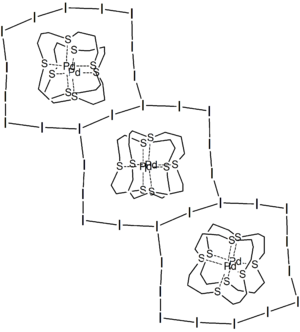Complete set of invariants: Difference between revisions
en>Nbarth terminology: necessary/sufficient |
(No difference)
|
Revision as of 03:07, 20 February 2010
The polyiodides are a class of polyhalogen anions composed of entirely iodine atoms. The most common and simplest member is the triiodide ion, I3−. Other known, larger polyiodides include [I4]2-, [I5]-, [I7]-, [I8]2-, [I9]-, [I10]2-, [I10]4-, [I11]-, [I12]2-, [I13]3-, [I16]2-, [I22]4-, [I26]3-, [I26]4-, [I28]4- and [I29]3-.[1]
Preparation
The polyiodides can be made by addition of stoichiometric amounts of I2 to solutions containing I− and I3−, with the presence of large counter-cations to stabilize them. For example, KI3•H2O can be crystallized from a saturated solution of KI when a stoichiometric amount of I2 is added and cooled.[2]
Structure


Polyiodides are characterized by their highly complex and variable structures, and can be considered as associations of I2, I−, and I3− units. Discrete polyiodides are usually linear, reflecting the origin of the ion. The more complex two- or three-dimensional network structures of chains and cages are formed as the ions interact with each other, with their shapes depend on their associated cations quite strongly. The table below lists the polyiodide salts which have been structurally characterized, along with their counter-cation.[3]
| Structure of higher polyiodides | ||
|---|---|---|
| Anion | Counter-cation | Structural description |
| [I3]- | Cs+ | linear |
| [I4]2- | [Cu(NH3)4]2+ | symmetric linear array of iodine atoms[4] |
| [I5]- | [EtMe3N]+ | V-shaped with polymeric layers |
| [EtMePh2N]+ | V-shaped with isolated [I5]- ions | |
| [I7]- | [Ag(18aneS6)]+ | an anionic network derived from a primitive rhombohedral lattice of iodide ions bridged by I2 molecules |
| [I8]2- | [Ni(phen)3]2+ | regular anionic shapes, can be described as [I3-•I2•I8-] or [I3-•I5-] |
| [I9]- | [Me2iPrPhN]+ | 14-membered ring tied by two I2 bridges to give 10-membered rings |
| [Me4N]+ | non-octahedral, but a twisted "h"-like arrangement of I3- and I2 units | |
| [I10]2- | [Cd(12-crown-4)2]2+ | twisted ring configuration with two [I3]- units linked by two I2 molecules |
| [I11]3- | [(16aneS4)PdIPd(16aneS4)]3+ | 14-membered ring (9.66 × 12.64 Å) around the complex cation, with the rings interlink further to give an infinite 2D sheet |
| [I12]2- | [Ag2(15aneS5)2]2+ | extended 3D spiral superstructure supported by Ag–I bonds and weak I•••S interactions |
| [Cu(Dafone)3]2+ | planar configuration | |
| [I13]3- | [Me2Ph2N]+ | consists of zigzag chains of I- and I2 |
| [I16]2- | [Me2Ph2N]+ | centrosymmetric arrangement of [I7-•I2•I7-] |
| [iPrMe2PhN]+ | the anion forms 14-membered rings catenated by I2 molecules, which further link into layers with 10- and 14-membered rings | |
| [I22]4- | [MePh3P]+ | two L-shaped [I5]- units linked by an I2 molecule and completed by two end-on [I5]- groups |
| [I26]3- | [Me3S]+ | consists of [I5]- and [I7]- ions with intercalated I2 molecules |
| [I26]4- | DMFc+ | an anionic network derived from a primitive cubic lattice built from I- ions, with I2 bridges on all edges and systematically removing of the I2 molecules |
| [I29]3- | Cp2Fe | an anionic 3D network with a cage-like structure of [{(I5-)0.5•I2}•{(I122-)0.5•I2}•I2], with [Cp2Fe]+ ions interacting with the anion in the cavities |

References
- ↑ 20 year-old Real Estate Agent Rusty from Saint-Paul, has hobbies and interests which includes monopoly, property developers in singapore and poker. Will soon undertake a contiki trip that may include going to the Lower Valley of the Omo.
My blog: http://www.primaboinca.com/view_profile.php?userid=5889534 - ↑ "Potassium triiodide" in Handbook of Preparative Inorganic Chemistry, 2nd Ed. Edited by G. Brauer, Academic Press, 1963, NY. Vol. 1. p. 294.
- ↑ 20 year-old Real Estate Agent Rusty from Saint-Paul, has hobbies and interests which includes monopoly, property developers in singapore and poker. Will soon undertake a contiki trip that may include going to the Lower Valley of the Omo.
My blog: http://www.primaboinca.com/view_profile.php?userid=5889534 - ↑ Per H. Svensson, Lars Kloo, "Synthesis, Structure, and Bonding in Polyiodide and Metal Iodide-Iodine Systems", Chem. Rev., (2003), 103(5), pp 1649-1684.
